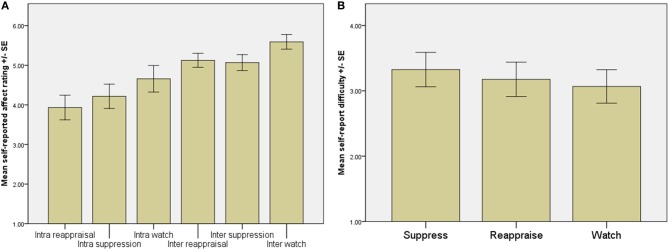Figure 2.

(A) Mean ratings for how emotional the participants felt (intrapersonal scan) or how emotional the participant judged the other person to be (interpersonal scan). There was a main effect of regulation strategy [F(2, 38) = 8.04, p < 0.01]. For intra- and interpersonal scans, emotions were higher in the watch condition in comparison to both the suppression (p < 0.05, p < 0.001 for intra- and interpersonal regulation, respectively) and reappraisal (p < 0.01, p < 0.001) conditions. During intrapersonal regulation, ratings were also significantly higher for suppression in comparison to reappraisal trials (p < 0.05) but not for interpersonal regulation. Ratings for the “intra” conditions refer to the participant's current affective state, whereas ratings for the “inter” conditions refer to what the participant judged the other person's affective state to be. (B) There was no main effect of regulation type on the difficulty of following instructions in the interpersonal regulation run [F(2, 38) = 0.55, p = 0.58], indicating that participants adhered to instructions and engaged in the relevant processes.
